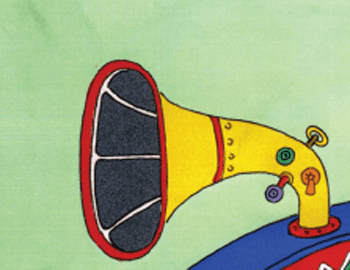Today we bring you Nicole Rudick's interview with the artists James Romberger and Marguerite Van Cook, two of the creators (with the late David Wojnarowicz) of one of this year's most impressive books, even if it is a reprint, 7 Miles a Second. Here's an excerpt:
The third part wasn’t completed until after his death. How did you manage it?
Romberger: When it came to the third part, I had a lot less to work with. David had given me the gist of what he wanted, which was “I want to show myself at the current time, mourning the deaths of my friends, but then in the end it’s a beautiful day and I’m happy to be alive.” But by the time I actually got to sit and draw this thing and edit it—after David’s death—there wasn’t anything like that in his texts. There was no beautiful day, so the book ends with him dying.
He had done this really magnificent bit of writing that was in part of the Artist’s Space book that had gotten him in so much trouble with the NEA, and he had told me, Draw me huge on Fifth Avenue. By that time, what I remembered being on Fifth Avenue was St. Patrick’s Cathedral, and David had once gone with Act Up to protest the church’s stand against public health and homosexuality, while mass was going on, so it made it sense to make Fifth Avenue St. Patrick’s and to draw him smashing it. These were decisions I had to make, but they are true to what his intent would have been, as close as I could approximate.
Did he think there would really be a happy ending to the third part? Or that there would be something good to end it with?
Romberger: In a way it’s a vulnerability we all feel—no one really sees themselves dying and if David had been able to hold on another year or two, perhaps the combination therapy that was developed within a couple years after he died might have saved him. A lot of people were brought back from the brink of death, and it is incredibly tragic that due to actions of people like David and others in Act Up—actions that got the medical establishment to loosen up on the approval of drugs trials—a lot of the work on AIDS and cancer was accelerated. And yet so many people died because things were being held off.
Van Cook: People were starting to be diagnosed and become ill, but that was something David wrote to us about in a letter—I’m rejecting that particular view of life and I’m going on to this brighter path. He didn’t want to be celebrating death and darkness anymore, as an artistic trope. He didn’t want to go down that artistic road, he wanted to go somewhere else. So even when things happened to him later on, he had embraced that more hopeful aspect.
Joe Ollmann is still in the middle of his excellent Cartoonist's Diary this week. In today's entry, he talks about his father's recent death.
Elsewhere:
—It's not strictly speaking comics-related, but it would be strange not to take note of film and special-effects pioneer Ray Harryahausen's passing. Journal columnist Charles Hatfield has posted a tribute.
—Chris Ware drew the Mother's Day cover for The New Yorker, and wrote a mini-essay for the site about the holiday.
—The New Yorker's site also has a short video interview with Dash Shaw.
—Sean Howe tags a Deadline story about the "absurdity" of some of the actors who appeared in The Avengers getting only $500,000 bonuses after the movie's success. I wonder if there is anyone else being overlooked in these arrangements?
—Boing Boing has begun publishing stories from Dennis Eichhorn's old Real Stuff comics, which is great news for me.
—The Dylan Williams Reporter site has reposted Williams' 1995 interview with Seth. It's a lot of fun to read the early interviews with major artists over there.
—The Beat talks to L Nichols.
—Finally, Curt Swan's letter to a young Jim Shooter.




























